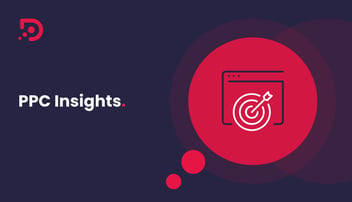PPC is an immediate and demonstrably effective way to reach potential customers, with B2C and B2B businesses alike standing to gain from implementing well-managed PPC campaigns.
For B2B businesses looking to improve their PPC strategies, there are a few important factors to take into account in addition to regular PPC considerations: things like longer sales cycles, higher value products and services, and a decision-making process with more steps.
In this article we’ll run through the fundamentals of B2B PPC strategies, giving you the information you need to effectively incorporate the factors above and to tap into the potential ROI and lead generation capabilities on offer.
Here’s what we’ll be covering:
- The Importance of a Tailored B2B PPC Strategy
- Key Elements of a Successful B2B PPC Campaign
- Advanced Techniques for B2B Lead Generation
- Measuring and Optimising Performance
The Importance of a Tailored B2B PPC Strategy
Anyone working in B2B will know that the buying cycle varies from B2C in significant ways. Let’s take a look at why:
- More steps in the decision-making process: In B2B, multiple stakeholders are involved, with individuals in different areas of the business (finance, leadership, etc.) weighing in. This is opposed to individuals making the decision for themselves in B2C.
- Longer sales cycle: B2B cycles can last weeks or even years, whereas a B2C sales cycle is more likely to last anywhere from a few minutes to a few days.
- More complex products and services: B2B businesses offer products and services designed to be used by businesses rather than individuals, meaning a higher level of complexity and greater difficulty integrating them with existing processes.
- More and different information requirements: In B2C, customers usually make decisions based on feelings and simple information, whereas stakeholders in a B2B environment will have specific criteria they need the product or service to meet. This may necessitate demos, technical specifications, trials, and so on.
- Greater financial obligations: B2C purchases are usually one-off, or purchased with a simple or pre-existing credit arrangement, whereas B2B transactions can be larger, more complex, and subject to negotiation.
Given all of these factors, it’s easy to see why B2B PPC campaigns need to be configured differently from B2C ones. The information that needs conveying must be adjusted to meet the specific needs of prospective B2B customers, the CTAs and ongoing engagement must be tailored to address the many and varied needs within the buying journey, and so on.
With these considerations in mind, you need to know from the outset that a one-size-fits-all approach does not work in B2B PPC. Each campaign must be built from the ground up to address the particular pain points of the prospective customer you’re targeting. And each campaign must be subject to ongoing monitoring, analysis and refinement to make performance improvements possible over time.
If you take just two things from this article, let it be the following:
- One-size-fits-all campaigns do not work in B2B PPC.
- B2B PPC isn’t fire-and-forget: campaigns need refinement over time.
Key Elements of a Successful B2B PPC Campaign

With the scene set and the need for tailored campaigns laid out, let’s take a look at the elements that define a successful campaign. Each of these is its own blog post, at least, so the information below is designed to give a workable summary.
To learn more about how to run a successful B2B PPC campaign, you can also get in touch with our team.
Targeted Keyword Research
Keywords are the building blocks of PPC campaigns. Your ads will display in searches for specified keywords, with the ad content, landing page content and onward journey being tied into their search intent. It’s crucial to get the right keywords, firstly to make sure you’re appearing in the right places, and secondly to ensure you’re not wasting money on irrelevant searches.
Here are some things to consider:
- Use short- and long-tail keywords: As a general rule long-tail terms have higher intent and lower competition, although search volumes will be lower. Combining long- and short-tail terms lets your campaigns cast a wider net.
- Use branded and non-branded keywords: Branded keywords will attract users who are familiar with your brand already, whereas non-branded ones will gain you visibility amongst users with fewer brand-specific queries.
- Use INCT keywords accordingly: INCT stands for informational, navigational, commercial and transactional, and each describes the top-level search intent for a keyword term. Users will have different needs depending on their position in the funnel, and targeting a range of keyword types will broaden your visibility.
- Phrasing: B2B campaigns may need to use industry language and jargon, but make sure your ad copy is eligible for your prospective users.
- Use keyword tools: tools like Google’s Keyword Planner, Ahrefs and Semrush have powerful keyword recommendation capabilities, and can help you to build lists of relevant terms with good traffic potential.
- Use negative keywords: Excluding keyword terms related that are adjacent to your target keywords but not relevant is an important way to minimise irrelevant traffic and improve overall campaign performance.
We’ve written in more depth about PPC keyword research here.
Landing Page Optimisation
Landing pages act as a bridge between clicks and conversions, and the most effective ones follow a clear set of principles:
- Concise copy: User attention is limited when browsing landing pages, so your copy needs to get straight to the point.
- Clearly relevant: Limited attention means you need to quickly demonstrate how the product or service you’re advertising is relevant to the user’s pain points.
- Clear and persuasive CTAs: Directing limited attention is much easier if you give users a clear action to take. Whether this is a button to click, a form to fill in or something else it should be simple and streamlined.
- Trust indicators: Users will look for signals that your business is trustworthy, and things like reviews, accolades, awards, or discounts will help to foster this trust.
- A/B testing: Comparing the performance of different copy, CTAs, page layouts, imagery, and myriad other elements will reveal ways in which your landing pages can be improved over time.
We’ve written in more depth about PPC landing pages here.
Ad Copy Relevance
We touched very briefly on ad copy in the previous section. Let’s take a closer look at what copy needs to do in a B2B PPC campaign:
- Present a coherent message: ad copy should align with a user’s search intent enough to convince them to click it, and the landing page copy should continue this chain of relevance. If the landing page copy makes different promises to the ad, users will leave.
- Resonate: B2B decision-makers will have very specific pain points they want to be addressed and your copy should clearly articulate how your product or service will do this.
- Clarity: The copy needs to be concise, as we’ve said, but it also needs to be clear. Paring down a copy is tricky: packing it with meaning is an art form.
We’ve written in more depth about PPC ad copy here.
Leveraging Audience Segmentation for Better Targeting
Audience segmentation lets you target different users with different ads, depending on their search behaviour, demographic information and so on. This is a powerful way to improve the targeting of your ads and the performance of your overall campaign.
- Segment by job title: With multifaceted decision-making processes and unique pain points at each level segmenting by job title lets you pitch different ads to different stakeholders, thereby addressing their specific pain points.
Creating Audience Personas and Tailoring Messaging
The most effective B2B PPC campaigns are those where guesswork is removed as much as possible, and a reliable way to do this is to create audience personas. These fictionalised representations of sections of your prospective customer base let you more accurately target ads and tailor messaging to the needs and pain points of different user types.
- Create personas: Persona creation is an in-depth process, but when done properly it pays dividends. We have put together a customer profile template here which is a good starting point for this process.
- Tailor your ad messaging to each persona: With personas created, you can write bespoke ads and landing page copy to target each. By addressing the needs of each persona individually, you maximise the relevance of your ads to the users engaging with them.
Effective Budget Allocation and Bid Management
PPC campaigns require ongoing management and optimisation to perform at their best, and part of this is changing budget allocation and bid management over time. Here’s what to consider:
- Budget planning: Past PPC performance is a good way to determine onward budget allocations: Look at key metrics and cross-reference this information with projected traffic (from keyword tools) to calculate a realistic spend.
- Sales cycle: An extended sales cycle relative to B2C means you need to take into account longer ad campaigns: Make sure your budget allocation reflects this.
- Choose the right bid strategy: Google gives you various options for bid strategies, with each suited to a particular campaign behaviour. For manual management of high-intent keywords, you might choose manual management, or for a more hands-off approach you could set a target CPC (cost per click) or CPA (cost per acquisition): Google will then bid automatically on your behalf up to these specified thresholds.
Maximising ROI with a Balanced Mix of Automation and Manual Bidding
Realistically, most B2B PPC campaigns will benefit from a combination of manual and automatic bidding strategies, with the balance to be determined by the specifics of the campaign.
- Automation is useful for saving time and leveraging Google’s algorithms to respond effectively to dynamic conditions.
- Manual is useful for giving you higher levels of control over your spending and potentially a clearer level of oversight into performance.
Advanced Techniques for B2B PPC Lead Generation

There are several ways to improve campaign performance or to capitalise on campaigns that are performing well already. These advanced techniques broaden the remit of your campaign by targeting a wider range of users in arenas beyond Google Search results pages.
Remarketing
We’ve written in-depth about remarketing here, but here’s a top-level summary of the concept.
Google Ads remarketing is a way for businesses to remain connected with potential customers after they leave your website. Businesses can use remarketing via the Google Display Network to keep their brand visible to users who have engaged and to encourage further interactions.
By incorporating remarketing into your campaigns, you can target prospective customers with ad content that is relevant to their needs beyond their original engagement with your search ads. This is a great way to nurture the lead, provide information relevant to their needs, and keep them in your ecosystem.
Advertising on LinkedIn and Other Relevant Platforms
While Google lends itself well to B2C and B2B advertising, some B2B businesses wish to advertise to a more B2B-centric audience. LinkedIn’s advertising tools are a response to this desire.
LinkedIn gives options for very detailed targeting on criteria like job title, industry, company size, and even skills. This allows advertisers to achieve much more granular targeting than would be possible elsewhere: ideal for reaching users directly with ad content relevant to their needs.
Bear in mind that LinkedIn ads are likely to be more expensive due to the greater accuracy of their targeting.
Measuring and Optimising Performance
Ongoing measurement and optimisation are just as crucial as taking care to design and implement an effective B2B PPC campaign. This stage of the process lets you review campaign performance data, draw conclusions about what’s working and what isn’t, and refine your campaign accordingly.
Key Performance Indicators (KPIs) for B2B PPC
Here are some of the metrics you should look out for to review campaign effectiveness:
- Cost Per Lead (CPL): the average cost per acquired lead, helpful for understanding whether or not the budget is being spent efficiently.
- Click-through Rate (CTR): the ratio of ad clicks to times your ad was shown, helpful in understanding whether or not your ads are engaging users as intended.
- Customer Lifetime Value (CLV): the average lifetime value of a customer acquired through PPC, helpful in conceptualising campaign ROI and advising future budget allocation.
These KPIs are relevant to B2B PPC campaigns because they reflect the longer sales cycle, the presence of multiple stakeholders, and the relative overall complexity of the process compared to B2C.
You can find other PPC metrics to track here.
A/B Testing
There are a lot of moving parts in a B2B PPC ad campaign, as we’ve seen. You’ve got target keywords, ad copy, landing page design, and bid settings, to name but a few.
Testing different variations of each of these moving parts is crucial in achieving optimised performance. Google allows you to test variations of ad copy, for example, so you can review which achieved the best engagement. You can also make changes to keywords and bid strategies over time, and review which led to the best performance.
The best B2B PPC campaigns are those subject to ongoing refinement based on analysis of campaign performance data.
In Conclusion
B2B PPC differs in subtle but important ways from B2C PPC. There is a longer sales cycle, customer needs are more complex, and multiple stakeholders are likely to be involved. For this reason, businesses need to build a solid understanding of the B2B PPC process to achieve success.
This article has looked at why it’s important to have this understanding, but also how to build it. We’ve explored the key elements of a successful campaign, with reference to keywords, ad design, landing page design, budget allocation, ad targeting, and more. Taken together, these are the areas that will determine how well your campaign performs.
Still looking for more information about PPC Services? We’ve got you covered. Find out more through one of the article below:
- B2B PPC: What is it & Why is it Important?
- PPC Management: How to Optimise Your Ad Campaigns
- PPC Keyword Research: A Comprehensive Guide
- PPC Ad Copy: A Comprehensive Guide
- PPC Landing Pages: A Comprehensive Guide
- PPC Tracking: A Comprehensive Guide
- PPC Analysis & Reporting: A Comprehensive Guide
- Why PPC Training Makes Sense for Marketing Managers
- How to Structure your PPC Campaign for Success
Or, why not check out our Definitive Guide to PPC Services.




